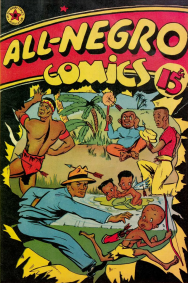The modern comics industry has a fascinating history, and this column is dedicated to spotlighting some of its milestones. Each installment focuses on three events that occurred in the same calendar month, but not the same decade. Here are three items from the month of June.

Orrin Cromwell Evans was a black reporter from Philadelphia in the 1940s. His work focused on inequality and pushed for fair treatment in various parts of society. He was the only black man on staff at the Philadelphia Record when he and other members of the Newspaper Guild went on strike, eventually leading to the paper’s failure. Seeking a new outlet for his ideas, Evans thought he could reach a wider audience through comics. He also thought this would be a more effective way to spread his opinions because his target readers had a high rate of illiteracy. So, at age 45, Evans recruited three partners and founded All Negro Comics, Inc, making him the first black comic publisher.
The first publication from the new company was appropriately titled “All Negro Comics.” The cover price was fifteen cents, which was atypically high at the time, and distribution was mostly limited to the Philadelphia area. Released with a June 1947 cover date, it contained 48 pages of all new content created exclusively by black writers and artists and starring black protagonists. The anthology included six stories (one detective, two adventure, two humor, and one fairy tale), a two-page prose story about a boy who helps catch a murderer, and a June calendar with notes indicating ways black people had contributed to world history. The issue was covered in the July 14, 1947 issue of Time magazine, which speculated the villains in the detective story would have been criticized as stereotypes if the creators had been white.
The comic also came with an introduction page written by Evans that made it clear this was meant to be a monthly series. A second issue was completed, but the vendor who had been Evans’s paper supplier no longer wished to do business with him. A replacement vendor couldn’t be found, forcing the new publisher to close its doors. Evans returned to the newspaper business, and later in life he voiced his suspicions that established comic publishers had pressured the paper vendors into abandoning him to avoid a new rival.

IBM released their Macintosh 128K computer system in the summer of 1984. Not long after, writer Peter B Gillis made a pitch to First Comics for a new comic conceived and designed to be created entirely on the computer. The plot was a cyberpunk story heavily influenced by Blade Runner, and the art would be done by Mike Saenz using only the default one-button mouse and a one-color screen that could only display 2/3 of a page at a time. Memory limitations meant the MacPaint program was on a floppy disk in the computer’s main drive and the work was saved on a second floppy disk in an external drive. If Saenz wanted to reuse a previous image, he’d have to change the disk. Coloring still had to be done by hand, but the lettering was done with the stock fonts available to the program.
The “Shatter” special was released with a June 1985 cover date and a $1.75 price tag, a full dollar over the average cover price at the time. To help justify the price, the comic was printed on higher quality Baxter stock instead of newsprint. Despite the hefty buy-in, heavy advertising helped First Comics sell through the 60,000 print run. “Shatter” then became a backup feature in “Jon Sable: Freelance” for the next six months. In December 1985, First Comics reprinted the first issue (and sold out again) as a lead in to making it an ongoing series. Issue two debuted in February 1986.
The effort was too much for Saenz, however, and he left the series after finishing issue two. The next four issues were drawn by hand before being scanned and digitized while First Comics looked for a replacement artist who could and would do it all on computer. Enter Charlie Athanas, who drew with a tablet and stylus instead of a mouse. He remained on the series until it was canceled at issue 14 in 1988.
Continued below
In 2009, Dr. Ian Williams attended a medical conference and gave a presentation about a medically-themed graphic novel and how he used it in his practice. Coincidentally, Maria Vaccarella and Columba Quigley independently included comic books in their presentations. The three medical professionals got together to discuss the intersection of comics and medicine, and they decided to team up to host a conference of their own devoted to the subject.
The first Comics & Medicine conference was held at the University of London on June 17, 2010 and attracted about 70 attendees. They developed and shared ideas on ways sequential art could be used to raise awareness about various healthcare topics. There were even sessions where doctors could learn about making comics of their own to use in their practice.
The success of the first conference led to it being an annual event, held in either June or July. Over the last eight years, venues have included Chicago, Seattle, and Toronto as the event has grown to a full weekend of talks and workshops. The 2018 conference had attendance over 180, and the 2019 conference being held in Brighton, England this July is expected to be bigger still.
Like these? Find previous editions of this column here.






